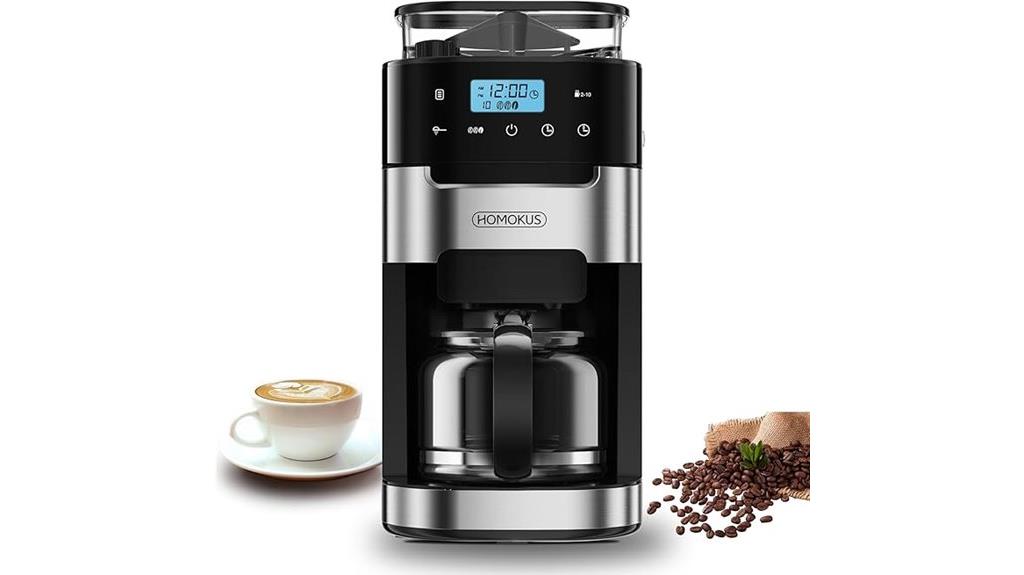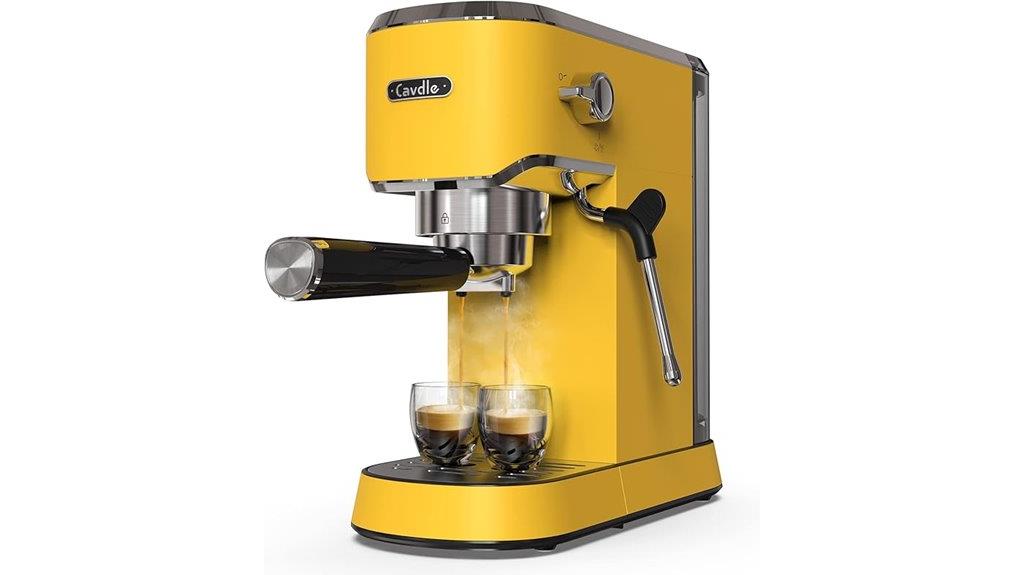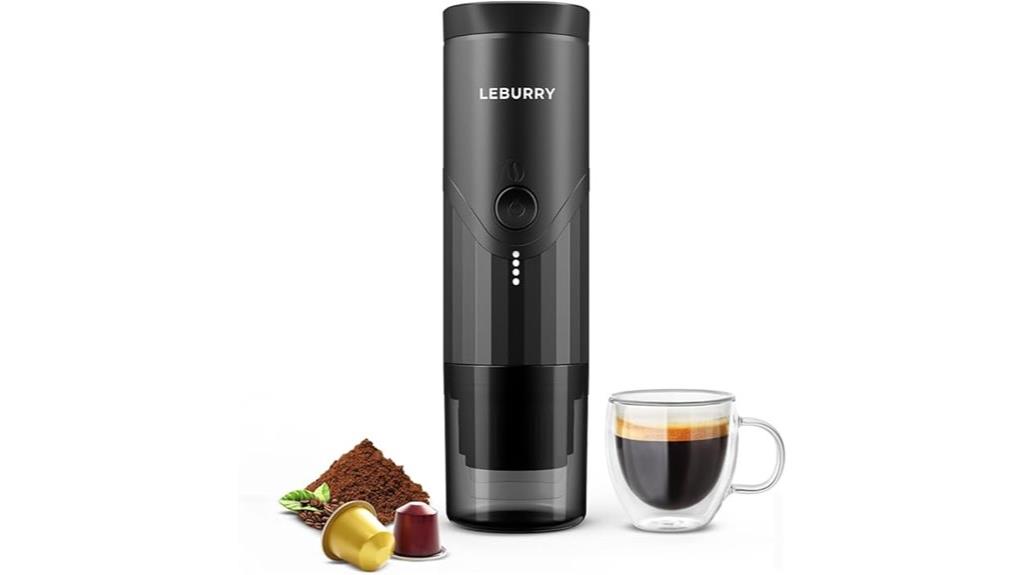



I've been exploring the Coffee Roast Degree/Particle Analyzer 2-in-1, and it's clear this device bridges a critical gap in coffee quality control. By combining roast uniformity analysis with precise grind size measurements, it offers a level of insight I haven't seen in other tools. But what really stands out is how it simplifies complex data into actionable steps—whether you're a professional barista or a home enthusiast. The question is, does it live up to its promises in real-world use? Let's break it down and see if this analyzer truly elevates your coffee game.
Key Takeaways
- Combines roast degree and particle size analysis into one device, saving time and improving accuracy for coffee professionals and enthusiasts.
- Uses 2D NIR imaging to measure roast uniformity across seven color bands and particle sizes from 100 µm to 2500 µm.
- Features a 2.8-inch touchscreen and DiFluid Café app integration for real-time data visualization and intuitive operation.
- Portable design with shockproof case, weighing 3.45 pounds, suitable for home, lab, or café use.
- SDK and OTA support enable customization and future updates, enhancing adaptability and long-term usability.
##
How does the Coffee Roast Degree/Particle Analyzer stand out in terms of functionality? I find its dual-functionality particularly impressive, combining roast degree and particle size analysis into a single device. It uses 2D Near-Infrared Imaging (NIR) to measure roast uniformity, breaking down color distribution into seven bands for precise identification. This guarantees consistent roast levels across batches. For particle consistency, the analyzer employs a smart automatic vibration device, resolving particle sizes from 100 µm to 2500 µm into nine distinct ranges. This granularity allows me to fine-tune grind settings for ideal extraction. The integration of SDK and OTA support further enhances its adaptability, enabling customization and updates to meet specific needs. Its precision in both roast uniformity and particle consistency makes it indispensable for achieving consistent coffee quality.
Features and Benefits
The analyzer's dual-functionality combines roast degree and particle size analysis, offering a thorough solution for quality control. Its 2D NIR imaging guarantees precise roast level identification, while the smart automatic vibration device enhances particle size distribution accuracy. The 2.8-inch HD touchscreen, integrated with the DiFluid Café app, provides an intuitive interface for real-time data visualization and analysis.
Dual-Functionality Roast and Particle Analysis
By combining roast degree and particle size analysis into a single device, this analyzer streamlines the process of evaluating coffee quality with unmatched efficiency. I can assess roast uniformity using 2D NIR imaging, which breaks down color distribution into seven precise bands, ensuring consistent roast profiles. Simultaneously, the smart vibration mechanism analyzes particle consistency, categorizing grind sizes into nine ranges from 100 µm to 2500 µm. This dual-functionality eliminates the need for separate tools, saving time while maintaining accuracy. The integration of roast and particle data allows me to identify correlations between roast level and grind performance, optimizing extraction and flavor. Whether I'm dialing in a brew or troubleshooting inconsistencies, this device delivers actionable insights with precision, making it indispensable for achieving quality control in coffee production.
D NIR Roast Degree Imaging
Precision in roast analysis is redefined with the 2D Near-Infrared Imaging (NIR) technology, which captures and interprets roast degree with exceptional accuracy. The NIR imaging accuracy guarantees that every detail of the roast color analysis is captured, breaking down the color distribution into seven distinct bands. This allows me to identify subtle variations in roast levels, maintaining consistency across batches. The system's ability to measure roast degrees from 0 to 150 on the Agtron scale provides a thorough view of the coffee's profile. By leveraging this advanced imaging, I can achieve a deeper understanding of the roast's uniformity, which is critical for both quality control and recipe development. The NIR technology truly elevates my ability to analyze and refine roast profiles with unmatched precision.
Smart Automatic Vibration Device
Building on the advanced capabilities of NIR imaging, the Smart Automatic Vibration Device enhances particle size analysis by guaranteeing consistent and uniform distribution of coffee grounds during measurement. I've found its vibration calibration to be a game-changer, as it eliminates clumping and secures an even spread of particles for accurate readings. The device's vibration optimization adjusts intensity based on sample density, which I've observed improves measurement precision across a wide particle size range (100 µm to 2500 µm). This feature is particularly useful when analyzing fine or coarse grinds, as it maintains consistency without manual intervention. By automating this process, it reduces human error and delivers reliable data, making it indispensable for professionals seeking repeatable results in roast and grind analysis.
.8-Inch HD Touchscreen Integration
With its 2.8-inch high-definition touchscreen, the analyzer delivers an intuitive and responsive interface that simplifies data visualization and interaction. The touchscreen responsiveness is exceptional, allowing me to navigate menus, adjust settings, and interpret results with minimal lag. The user interface design is clean and logically organized, ensuring I can access roast degree and particle size data without confusion. I appreciate how the DiFluid Café app integration enhances functionality, enabling seamless control and real-time updates. The screen's clarity and brightness make it easy to read in various lighting conditions, which is essential for both lab and on-site use. This integration not only improves usability but also elevates the overall efficiency of the analyzer, making it a standout feature for professionals and enthusiasts alike.
Product Quality
While evaluating the product quality of the Coffee Roast Degree/Particle Analyzer, I found its dual-functionality and precision engineering to be standout features. The build durability is exceptional, with a matte-finished exterior that resists scratches and wear, ensuring long-term use in demanding environments. The materials used, including the shockproof travel case and robust internal components, highlight the device's material longevity. The 2.8-inch HD touchscreen is securely integrated, and the 58mm sample tray is crafted from high-grade, corrosion-resistant materials. The analyzer's compact design doesn't compromise structural integrity, and its 3.45-pound weight strikes a balance between portability and sturdiness. Overall, the product's construction reflects meticulous attention to detail, making it a reliable tool for both professional and home use.
What It's Used For
I use this analyzer to identify roast levels with 2D NIR imaging, ensuring precise color distribution across seven bands for consistent roasting profiles. It also measures particle size distribution from 100 µm to 2500 µm, breaking it into nine ranges to optimize grind uniformity. This data helps me fine-tune brewing parameters, achieving consistent extraction and flavor balance in every cup.
Roast Level Identification
Roast level identification is a critical process in coffee production, guaranteeing consistency and quality across batches. I rely on roast color analysis to measure the degree of roast, using 2D Near-Infrared Imaging (NIR) to capture precise color data. This method breaks down the roast into seven distinct color bands, allowing me to assess roast uniformity across the entire batch. By analyzing these bands, I can identify inconsistencies, such as underdeveloped or over-roasted beans, which directly impact flavor and aroma. The device's Agtron scale (0-150) provides a standardized reference, making it easier to replicate desired roast profiles. Roast uniformity assessment is equally crucial, as it guarantees even heat distribution and prevents defects, ultimately delivering a balanced cup. This level of precision is indispensable for both small-scale and commercial roasters.
Particle Size Distribution
Particle size distribution plays a significant role in determining the extraction efficiency and overall quality of brewed coffee. When I analyze grind uniformity, I focus on how evenly the coffee particles are sized, as this directly impacts the rate of extraction. If the grind lacks particle consistency, fines and boulders can lead to over-extraction or under-extraction, respectively, resulting in imbalanced flavors. By measuring particle size distribution, I can identify inconsistencies and adjust grind settings to achieve ideal uniformity. This guarantees that water flows evenly through the coffee bed, extracting soluble compounds uniformly. Precise particle size analysis, down to 100 µm resolution, allows me to fine-tune brewing parameters, enhancing clarity and balance in the final cup. It's a critical step for achieving repeatable, high-quality results.
Brewing Consistency Optimization
Brewing consistency optimization is about guaranteeing that every cup of coffee meets the same high standard, regardless of variables like grind size, water temperature, or brew time. I rely on tools like the DiFluid analyzer to achieve grind uniformity, which directly impacts extraction precision. By analyzing particle size distribution, I can identify inconsistencies in the grind, securing even water flow and balanced extraction. The device's 2D NIR imaging and particle resolution down to 100 µm allow me to fine-tune my grind settings, eliminating over- or under-extraction risks. This level of control guarantees that each brew delivers consistent flavor profiles, whether I'm working in a lab, café, or at home. It's a game-changer for anyone serious about perfecting their coffee craft.
Product Specifications
The Coffee Roast Degree/Particle Analyzer combines advanced technology with a compact design to deliver precise measurements for both roast degree and particle size. Its technical specifications include a 2D Near-Infrared Imaging (NIR) system for roast degree identification and a smart vibration device for particle size analysis. The device measures roast levels from 0 to 150 (Agtron) and particle sizes between 100 µm and 2500 µm, guaranteeing high measurement accuracy. Below is a breakdown of its core specs:
| Feature | Range/Resolution | Technology Used |
|---|---|---|
| Roast Degree | 0 to 150 (Agtron) | 2D NIR Imaging |
| Particle Size | 100 µm to 2500 µm | Smart Vibration Device |
| Display | 2.8-inch HD Touchscreen | DiFluid Café App |
| Dimensions | 4.7D x 4.7W x 6.6H inches | Compact, Portable Design |
| Weight | 3.45 pounds | Shockproof Travel Case |
This analyzer guarantees uniformity and precision, making it indispensable for professionals.
Who Needs This
With its dual-functionality and precise measurement capabilities, this analyzer is designed for those who demand accuracy in both roast degree and particle size analysis. As a coffee enthusiast, I appreciate how it bridges the gap between home experimentation and professional-grade tools, offering detailed insights into roast uniformity and grind consistency. For professional roasters, it's indispensable—its 2D NIR imaging and particle resolution down to 100 µm guarantee repeatability and quality control. Whether you're running a specialty coffee shop, a roasting academy, or a lab, this device provides actionable data to optimize your workflow. Its portability and SDK support make it versatile for both commercial and home use. If you're serious about elevating your coffee game, this analyzer is a must-have.
Pros
Combining roast degree and particle size analysis into a single device, this analyzer delivers unmatched versatility for coffee professionals and enthusiasts alike. Its portable design makes it easy to carry between home, lab, or café settings, while its affordable pricing guarantees accessibility without compromising on performance. Here's why I find it exceptional:
- Dual-functionality: The 2D Near-Infrared Imaging (NIR) for roast degree and smart vibration for particle size analysis provide precise, actionable data in one compact unit.
- High-resolution touchscreen: The 2.8-inch display, paired with the DiFluid Café app, offers intuitive navigation and detailed insights into color and particle distribution.
- Customizable SDK support: It allows for tailored updates and integration, guaranteeing adaptability to evolving needs.
This analyzer is a game-changer for anyone serious about coffee quality and consistency.
Cons
While the analyzer excels in versatility and performance, it's not without its limitations. Here are the key drawbacks I've observed:
- High maintenance cost: The device requires regular calibration and cleaning to maintain accuracy, which can add up over time. Replacement parts, like the reusable filter, also contribute to ongoing expenses.
- Limited portability: Despite its compact design, the analyzer's weight (3.45 pounds) and reliance on a stable surface for precise measurements make it less ideal for on-the-go use.
- Complexity for beginners: While the 2.8-inch touchscreen and app integration are user-friendly, the advanced features like SDK customization may overwhelm casual users or those new to coffee analysis.
These factors could deter some users, especially those seeking a low-maintenance, highly portable solution.
What Customers Are Saying
Customer feedback highlights a strong appreciation for the analyzer's dual-functionality and precision. Users consistently praise its ability to deliver accurate roast degree and particle size data, which enhances their workflow and guarantees consistency in coffee quality. The 2D Near-Infrared Imaging and smart vibration device are frequently mentioned as standout features, contributing to a seamless user experience. Many reviewers note the intuitive 2.8-inch touchscreen and DiFluid Café app integration as key factors in their satisfaction, making the device accessible even for those new to coffee analysis. The portability and shockproof case also receive high marks, particularly from professionals who need reliable tools on the go. Overall, customer satisfaction stems from its blend of advanced technology, ease of use, and professional-grade results.
Overall Value
The analyzer's dual-functionality and precision, as highlighted by customer feedback, underscore its value proposition in the coffee industry. Its ability to measure both roast degree and particle size with high accuracy, combined with features like 2D NIR imaging and smart vibration, positions it as a versatile tool for professionals and enthusiasts alike. When considering cost comparison, it stands out as a cost-effective alternative to high-end devices like Agtron ($10k+) and Lighttells CM200 ($2500). Its market positioning bridges the gap between affordability and advanced functionality, making it accessible for small-scale roasters and home users without compromising on performance. For its price point, the inclusion of SDK support, OTA updates, and detailed data analysis further solidifies its overall value in a competitive market.
Tips and Tricks For Best Results
To achieve peak performance with the Coffee Roast Degree/Particle Analyzer, calibrating the device before each use is essential, guaranteeing consistent and accurate readings. I always follow precise calibration techniques, using the included reference standards to align the NIR imaging and particle sensors. For sample preparation, I guarantee the coffee grounds are evenly distributed in the 58mm sample tray, avoiding clumps or uneven layers that could skew results. I also clean the reusable filter and tray after every use to prevent cross-contamination. When analyzing roast degree, I make sure the sample is dry and free of oils, as moisture can interfere with NIR readings. For particle size analysis, I use the smart vibration feature to achieve a uniform spread, enhancing measurement precision.
Conclusion
Having explored the calibration and preparation techniques for ideal results, it's clear that the Coffee Roast Degree/Particle Analyzer stands out as a versatile tool for both home and professional use. Its dual-functionality, combining roast degree and particle size analysis, delivers precise data critical for consistency and quality control. The integration of 2D NIR imaging and smart vibration technology guarantees accuracy, while the SDK and OTA support hint at future advancements in customization and adaptability. For the coffee industry, this device's affordability and portability could greatly influence small-scale roasters and specialty coffee traders, democratizing access to advanced analytics. As the industry evolves, tools like this will likely set new standards, bridging the gap between lab-grade precision and everyday usability.
Disclosure: As an Amazon Associate, I earn from qualifying purchases.




